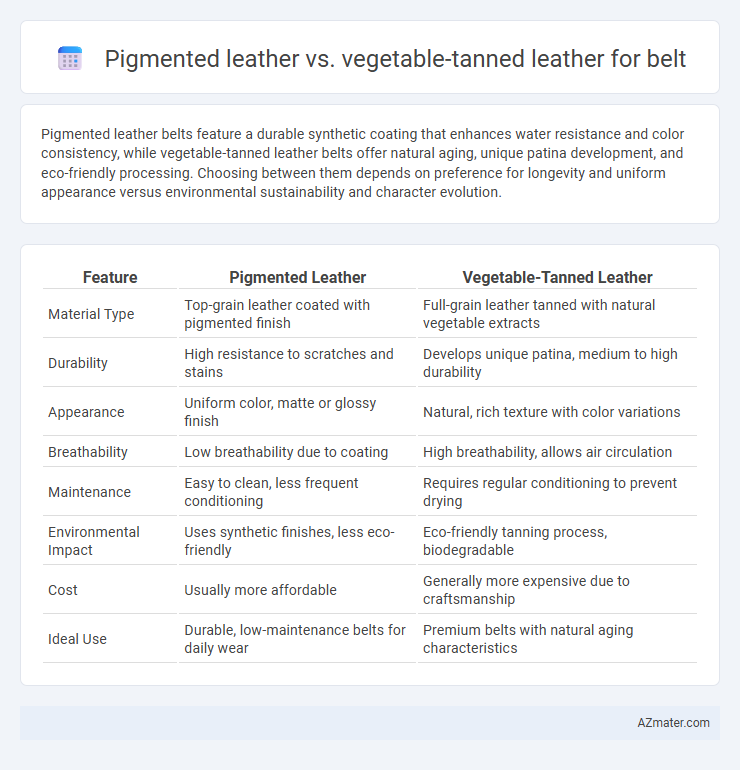Pigmented leather belts feature a durable synthetic coating that enhances water resistance and color consistency, while vegetable-tanned leather belts offer natural aging, unique patina development, and eco-friendly processing. Choosing between them depends on preference for longevity and uniform appearance versus environmental sustainability and character evolution.
Table of Comparison
| Feature | Pigmented Leather | Vegetable-Tanned Leather |
|---|---|---|
| Material Type | Top-grain leather coated with pigmented finish | Full-grain leather tanned with natural vegetable extracts |
| Durability | High resistance to scratches and stains | Develops unique patina, medium to high durability |
| Appearance | Uniform color, matte or glossy finish | Natural, rich texture with color variations |
| Breathability | Low breathability due to coating | High breathability, allows air circulation |
| Maintenance | Easy to clean, less frequent conditioning | Requires regular conditioning to prevent drying |
| Environmental Impact | Uses synthetic finishes, less eco-friendly | Eco-friendly tanning process, biodegradable |
| Cost | Usually more affordable | Generally more expensive due to craftsmanship |
| Ideal Use | Durable, low-maintenance belts for daily wear | Premium belts with natural aging characteristics |
Understanding Pigmented Leather
Pigmented leather features a surface coating of pigment that offers enhanced durability, consistent color, and resistance to stains and fading, making it ideal for everyday belt wear. This leather type masks natural marks and imperfections, providing a uniform appearance that appeals to customers seeking low-maintenance accessories. Unlike vegetable-tanned leather, pigmented leather requires less conditioning and protection, resulting in belts that maintain a fresh look over extended use.
What is Vegetable-Tanned Leather?
Vegetable-tanned leather is crafted using natural tannins extracted from tree bark, leaves, and other organic materials, resulting in a durable and environmentally friendly material that develops a rich patina over time. Unlike pigmented leather, which is coated with a synthetic layer to mask imperfections, vegetable-tanned leather retains the hide's natural texture and unique markings, enhancing the belt's character and authenticity. This leather type is favored for belts due to its firmness, breathability, and ability to age beautifully with regular use.
Key Differences Between Pigmented and Vegetable-Tanned Leather
Pigmented leather features a synthetic coating that enhances durability and water resistance, making it ideal for heavy-use belts but often masks the natural grain and color variations. Vegetable-tanned leather undergoes an eco-friendly tanning process using natural tannins, resulting in a distinctive patina that deepens over time and offers a more authentic, breathable finish. Key differences include the pigmented leather's uniform appearance and higher scratch resistance versus the vegetable-tanned leather's natural aging process and unique, individualized character.
Durability: Pigmented vs Vegetable-Tanned Leather Belts
Pigmented leather belts feature a protective topcoat that enhances resistance to scratches, stains, and moisture, resulting in superior durability for daily wear. Vegetable-tanned leather belts develop a natural patina over time but are more susceptible to water damage and surface wear without additional treatments. Choosing pigmented leather ensures longer-lasting structural integrity, while vegetable-tanned leather offers a unique aging experience at the cost of increased maintenance.
Appearance and Aging: How Each Leather Types Ages
Pigmented leather maintains a uniform, smooth finish with minimal color changes over time, making it highly resistant to scratches and stains but often lacks natural aging characteristics. Vegetable-tanned leather develops a rich patina and deepens in color as it ages, showcasing natural marks and a unique texture that enhances its vintage appeal. This natural aging process on vegetable-tanned leather results in a more personalized and character-rich appearance, contrasting the consistent look of pigmented leather belts.
Comfort and Flexibility for Everyday Wear
Pigmented leather offers a durable surface with a consistent finish but tends to be less breathable and flexible compared to vegetable-tanned leather, which develops softness and pliability over time, enhancing comfort for everyday wear. Vegetable-tanned leather molds to the body's shape, providing superior flexibility and a natural feel that improves with regular use. For belts, the choice between pigmented and vegetable-tanned leather significantly impacts long-term comfort and the belt's ability to adapt to daily movements.
Maintenance and Care Requirements
Pigmented leather requires minimal maintenance due to its protective coating that resists stains, scratches, and moisture, making it ideal for users seeking low-effort care. Vegetable-tanned leather demands regular conditioning and attention to prevent drying, cracking, and water damage, as its natural finish absorbs oils and patina over time. For belt longevity, pigmented leather suits those preferring durability with less maintenance, while vegetable-tanned leather appeals to enthusiasts valuing natural aging and restoration through consistent care.
Environmental Impact and Sustainability
Pigmented leather undergoes heavy chemical treatment and coating, leading to significant environmental pollution and limited biodegradability, whereas vegetable-tanned leather uses natural tannins from plants, promoting a more eco-friendly and sustainable production process. Vegetable tanning typically consumes less energy and produces fewer harmful effluents, making it a preferred choice for environmentally conscious consumers seeking durable, biodegradable belts. The sustainable forestry practices linked to vegetable tanning also support biodiversity and reduce harmful chemical runoff compared to pigmented leather manufacturing.
Price Comparison: Which Leather Offers More Value?
Pigmented leather belts tend to be more affordable due to mass production and synthetic coatings that increase durability at a lower cost. Vegetable-tanned leather belts, though priced higher, offer greater long-term value through natural aging, developing unique patina and enhanced strength over time. Buyers seeking cost-effective options may prefer pigmented leather, while those prioritizing craftsmanship and longevity may find vegetable-tanned leather belts more valuable.
Which Leather is Best for Belts? Final Recommendations
Pigmented leather offers a durable, uniform finish with excellent resistance to water and stains, making it ideal for belts requiring long-lasting color and low maintenance. Vegetable-tanned leather provides a natural, rich patina that develops character over time, preferred by those seeking an authentic, classic look and eco-friendly tanning methods. For belts, choose pigmented leather for durability and ease of care, while vegetable-tanned leather suits users prioritizing aesthetics and natural aging.

Infographic: Pigmented leather vs Vegetable-tanned leather for Belt
 azmater.com
azmater.com